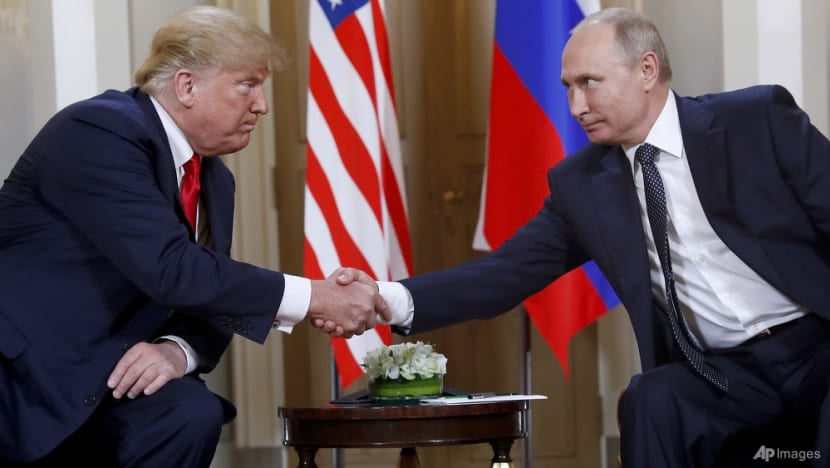Commentary: President-elect Trump is bad news for Ukraine and Europe
The expectation of US president-elect Donald Trump pushing for an end to Russia’s war in Ukraine is likely going to lead to more intense fighting in the short term, says international security expert Stefan Wolff.


This audio is generated by an AI tool.
BIRMINGHAM, England: Donald Trump must feel like nothing can stop him right now. He will return to the White House in January 2025. His policies and key appointments will likely face little resistance in Congress, given his Republican allies will control the Senate and possibly also the House of Representatives.
The war in Ukraine is among the key issues that Trump will likely tackle early on in his second term, possibly even before he takes office, as he claimed he would in the June debate against then candidate Joe Biden. He just pulled off a historic comeback - why not “settle” Russia and Ukraine next?
A Trump deal will most likely mean pushing Kyiv and Moscow to agree on a ceasefire along the current frontlines and then start negotiations on a permanent settlement.
BAD NEWS FOR UKRAINE?
Ukrainian President Volodymyr Zelenskyy has congratulated Trump on his victory, but he must be putting on a brave face at the prospect of what is to come.
Ukraine’s biggest military backer will now be led by someone who has repeatedly threatened to withdraw support, called Zelenskyy “the greatest salesman” for securing billions in aid from Washington, and claimed he would quickly end the war - “in 24 hours” even - without explaining what peace would look like.
In all probability, any peace agreement would be more on Russia’s terms than Ukraine’s: Ukrainian acceptance of Russia’s territorial gains, including the annexation of Crimea in 2014 and the territories occupied since the full-scale invasion of Ukraine in February 2022. Trump is also likely to accept demands by Russian President Vladimir Putin to prevent a future Ukrainian membership to the North Atlantic Treaty Organization (NATO).
Given Trump’s well-known animosity to NATO, this would also put pressure on Kyiv’s European allies: Trump could, once again, threaten to abandon the alliance in order to get Europeans to sign up to a deal with Putin.
GETTING VLADIMIR PUTIN TO THE TABLE
But for a deal to work, even in the short term, Trump will also need Putin to sign it.
Putin is not under any particular pressure right now to accept just any deal. Russia is still making gains in Donbas and pushing back in Kursk with the deployment of North Korean troops.
In the same way in which he will likely threaten to cut all support from Kyiv to get Zelenskyy to come onboard, Trump could alternatively also put pressure on Moscow by considering more military support for Ukraine and removing all constraints on the use of US and allied weapons, including against targets deep inside Russia.
This would not necessarily lead to an immediate Ukrainian victory, but it would make a Russian one impossible for the foreseeable future and might reverse some of its recent gains in eastern Ukraine. Given Trump’s unpredictability, this may not be a bluff that Putin would dare to call.
EXPECT FIGHTING TO INTENSIFY
Yet, even if Trump were to make his calls to Putin and Zelenskyy almost immediately, the expectation of him pushing for an end to the war is likely going to lead to an intensification of the fighting.
Moscow and Kyiv would both be keen to achieve a better bargaining position ahead of any negotiations. This would mean another strong push by Russia in eastern Ukraine, increasing attacks on Ukrainian critical infrastructure, and potentially more North Korean soldiers involved in the fighting in Russia’s Kursk region.
Ukraine, by contrast, would likely mobilise whatever resources it has left to try to hold on to territory inside Russia as a bargaining chip in future negotiations and push back, or at least hold, the current front lines.
Regardless the outcome of either side’s efforts, none of this bodes well for the humanitarian crisis already brewing in Ukraine.
WILL RUSSIA ABIDE BY ANY PEACE TERMS?
A ratcheting-up of the fighting in Ukraine is also likely to strain relations between the US and its allies in Europe. Here, the fear is that Trump will likely make deals with Russia over the head of its EU and NATO allies and threaten them with abandonment.
This would undermine the longevity of any deal with Moscow. Since the start of the invasion, no one has been convinced Russia would stick to any brokered peace terms.
The relatively dismal state of European defence capabilities and the diminishing credibility of the US nuclear umbrella could not but encourage Putin to push his imperial ambitions further once he has secured a deal with Trump.
If the US, by then, were to have completed the strategic withdrawal from Europe that Trump envisages in order to focus more on competition with China, an unconstrained Putin might take his gamble beyond Ukraine and threaten NATO directly.
If it came to that, Trump could find his actions described once again as “historic” - as the US president who repeated the mistake of former British prime minister Neville Chamberlain in 1938 who thought he could make a deal with Nazi Germany that would bring “peace in our time”.
Stefan Wolff is Professor of International Security at the University of Birmingham and Head of the Department of Political Science and International Studies.


















